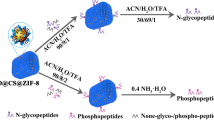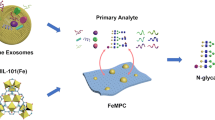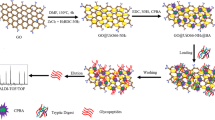Abstract
Protein glycosylation plays a key role in many biological processes. In this study, a novel carbon material with nanopores was prepared by carbonization of metal–organic framework (MOF) Mil-101(Cr). The parent MOF assembled from metal ions with bridging organic linkers had many fascinating properties, such as ultrahigh surface area, suitable nanopore structure, and especially a large amount of carbon after being calcined. Due to the strong interactions between carbon and glycans as well as the size-exclusion effect of pore against protein, the N-linked glycans from standard glycoprotein or complex human serum proteins could be identified with high efficiency. The simple synthesis method as well as good enrichment efficiency made this novel carbon material a promising tool for glycosylation research.







Similar content being viewed by others
References
Ohtsubo K, Marth JD. Glycosylation in cellular mechanisms of health and disease. Cell. 2006;126:855–67.
Helenius A, Aebi M. Intracellular functions of N-linked glycans. Science. 2001;291:2364–9.
Pang PC, Chiu PCN, Lee CL, Chang LY, Panico M, Morris HR, et al. Human sperm binding is mediated by the Sialyl-Lewisx oligosaccharide on the zona pellucida. Science. 2011;333:1761–4.
Wang JX, Wang YN, Gao MX, Zhang XM, Yang PY. Multilayer hydrophilic poly(phenol-formaldehyde resin)-coated magnetic graphene for boronic acid immobilization as a novel matrix for glycoproteome analysis. ACS Appl Mater Interfaces. 2015;7:16011–7.
Qin HQ, Zhao L, Li RB, Wu RA, Zou HF. Size-selective enrichment of N-linked glycans using highly ordered mesoporous carbon material and detection by MALDI-TOF MS. Anal Chem. 2011;83:7721–8.
Dennis JW, Nabi IR, Demetriou M. Metabolism, cell surface organization, and disease. Cell. 2009;139:1229–41.
Zhang W, Wang H, Tang HL, Yang PY. Endoglycosidase-mediated incorporation of 18O into glycans for relative glycan quantitation. Anal Chem. 2011;83:4975–81.
Chen SM, LaRoche T, Hamelinck D, Brenner D, Bergsma D, Simeone D, et al. Multiplexed analysis of glycan variation on native proteins captured by antibody microarrays. Nat Methods. 2007;4:437–44.
Zhang LJ, Jiang HC, Yao J, Wang YL, Fang CY, Yang PY, et al. Highly specific enrichment of N-linked glycopeptides based on hydrazide functionalized soluble nanopolymers. Chem Commun. 2014;50:1027–9.
Budnik BA, Lee RS, Steen JAJ. Global methods for protein glycosylation analysis by mass spectrometry. Biochim Biophys Acta. 1764;2006:1870–80.
Block TM, Comunale MA, Lowman M, Steel LF, Romano PR, Fimmel C, et al. Use of targeted glycoproteomics to identify serum glycoproteins that correlate with liver cancer in woodchucks and humans. Proc Natl Acad Sci U S A. 2005;102:779–84.
Wang YN, Wang JX, Gao MX, Zhang XM. An ultra hydrophilic dendrimer-modified magnetic graphene with a polydopamine coating for the selective enrichment of glycopeptides. J Mater Chem B. 2015;3:8711–6.
Bereman MS, Williams TI, Muddiman DC. Development of a nanoLC LTQ orbitrap mass spectrometric method for profiling glycans derived from plasma from healthy, benign tumor control, and epithelial ovarian cancer patients. Anal Chem. 2009;81:1130–6.
Bones J, Mittermayr S, O’Donoghue N, Guttman A, Rudd PM. Ultra performance liquid chromatographic profiling of serum n-glycans for fast and efficient identification of cancer associated alterations in glycosylation. Anal Chem. 2010;82:10208.
Selman MHJ, Hemayatkar M, Deelder AM, Wuhrer M. Cotton HILIC SPE microtips for microscale purification and enrichment of glycans and glycopeptides. Anal Chem. 2011;83:2492–249.
Ruhaak LR, Miyamoto S, Kelly K, Lebrilla CB. N-glycan profiling of dried blood spots. Anal Chem. 2012;84:396–402.
Packer NH, Lawson MA, Jardine DR, Redmond JW. A general approach to desalting oligosaccharides released from glycoproteins. Glycoconj J. 1998;15:737–47.
Fan JQ, Kondo A, Kato I, Lee YC. High-performance liquid chromatography of glycopeptides and oligosaccharides on graphitized carbon columns. Anal Biochem. 1994;219:224–9.
de Leoz MLA, An HJ, Kronewitter S, Kim J, Beecroft S, Vinall R, et al. Glycomic approach for potential biomarkers on prostate cancer: profiling of N-linked glycans in human sera and pRNS cell lines. Dis Markers. 2008;25:243–58.
Li JR, Sculley J, Zhou HC. Metal organic frameworks for separations. Chem Rev. 2012;112:869–932.
Jiang JC, Yaghi OM. Brønsted acidity in metal-organic frameworks. Chem Rev. 2015;115:6966–97.
Farrusseng D, Aguado S, Pinel C. Metal-organic frameworks: opportunities for catalysis. Angew Chem Int Ed. 2009;48:7502–13.
Na K, Choi KM, Yaghi OM, Somorjai GA. Metal nanocrystals embedded in single nanocrystals of MOFs give unusual selectivity as heterogeneous catalysts. Nano Lett. 2014;14:5979–83.
Wang C, Liu DM, Lin WB. Metal-organic frameworks as a tunable platform for designing functional molecular materials. J Am Chem Soc. 2013;135:13222–34.
Gu ZY, Yang CX, Chang N, Yan XP. Metal organic frameworks for analytical chemistry: from sample collection to chromatographic separation. Acc Chem Res. 2012;45:734–45.
Gu ZY, Chen YJ, Jiang JQ, Yan XP. Metal–organic frameworks for efficient enrichment of peptides with simultaneous exclusion of proteins from complex biological samples. Chem Commun. 2011;47:4787–9.
Zhao M, Deng CH, Zhang XM, Yang PY. Facile synthesis of magnetic metal organic frameworks for the enrichment of low-abundance peptides for MALDI-TOF MS analysis. Proteomics. 2013;13:3387–92.
Messner CB, Mirza MR, Rainer M, Lutz OMD, Guzel Y, Hofer TS, et al. Selective enrichment of phosphopeptides by a metal–organic framework. Anal Methods. 2013;5:2379–83.
Zhao M, Deng CH, Zhang XM. Chem Commun. 2014;50:6228–31.
Chen YJ, Xiong ZC. Peng L, Gan YY, Zhao YM, ShenmJ, Qian JH, Zhang LY, Zhang WB. Facile preparation of core−shell magnetic metal−organic framework nanoparticles for the selective capture of phosphopeptides. ACS Appl Mater Interfaces. 2015;7:16338–47.
Liu B, Shioyama H, Akita T, Xu Q. Metal-organic framework as a template for porous carbon synthesis. J Am Chem Soc. 2008;130:5390–1.
Banerjee A, Gokhale R, Bhatnagar S, Jog J, Bhardwaj M, Lefez B, et al. MOF derived porous carbon-Fe3O4 nanocomposite as a high performance, recyclable environmental superadsorbent. J Mater Chem. 2012;22:9694–19699.
Torad NL, Hu M, Kamachi Y, Takai K, Imura M, Naitoa M, et al. Facile synthesis of nanoporous carbons with controlled particle sizes by direct carbonization of monodispersed ZIF-8 crystals. Chem Commun. 2013;49:2521–3.
Sun NR, Deng CH, Li Y, Zhang XM. Highly selective enrichment of N-linked glycan by carbon functionalized ordered graphene/mesoporous silica composites. Anal Chem. 2014;86:2246–50.
Zhang QQ, Zhang QH, Xiong ZH, Wan H, Chen XT, Zou HF. Facile preparation of carbon-functionalized ordered magnetic mesoporous silica composites for highly selective enrichment of N-glycans. RSC Adv. 2015;5:68972–80.
Cao N, Tan SY, Luo W, Hu K, Cheng GZ. Ternary CoAgPd nanoparticles confined inside the pores of MIL-101 as efficient catalyst for dehydrogenation of formic acid. Catal Lett. 2016;146:518–24.
Férey G, Mellot-Draznieks C, Serre C, Millange F, Dutour J, Surble S, et al. A chromium terephthalate-based solid with unusually large pore volumes and surface area. Science. 2005;309:2040–2.
Gai S, Yang P, Li C, Wang W, Dai Y, Niu N, et al. Synthesis of magnetic, up-conversion luminescent, and mesoporous core–shell-structured nanocomposites as drug carriers. Adv Funct Mater. 2010;20:1166–72.
Sun NR, Zhang XM, Deng CH. Designed synthesis of MOF-derived magnetic nanoporous carbon materials for selective enrichment of glycans for glycomics analysis. Nanoscale. 2015;7:6487–91.
Acknowledgments
This work was supported by National Basic Research Program of China (Project: 2012CB910604), the National High-Tech R&D Program (Project: 2012AA020202), and the National Natural Science Foundation of China (Project: 21275034 and 21475027).
Authors’ contributions
All authors have given approval of the final version of the manuscript.
Author information
Authors and Affiliations
Corresponding author
Ethics declarations
Conflict of interest
The authors declare that they have no competing interest.
Ethical approval
The research followed the tenets of the Declaration of Helsinki, and the use of the human serum samples for research was approved by the Ethics Committee of Zhongshan Hospital, Fudan University. All individual participants gave informed consent for the use of these samples.
Additional information
Published in the topical collection Glycomics, Glycoproteomics and Allied Topics with guest editors Yehia Mechref and David Muddiman.
Electronic supplementary material
Below is the link to the electronic supplementary material.
ESM 1
(PDF 1.39 mb)
Rights and permissions
About this article
Cite this article
Wang, Y., Wang, J., Gao, M. et al. A novel carbon material with nanopores prepared using a metal–organic framework as precursor for highly selective enrichment of N-linked glycans. Anal Bioanal Chem 409, 431–438 (2017). https://doi.org/10.1007/s00216-016-9796-1
Received:
Revised:
Accepted:
Published:
Issue Date:
DOI: https://doi.org/10.1007/s00216-016-9796-1




